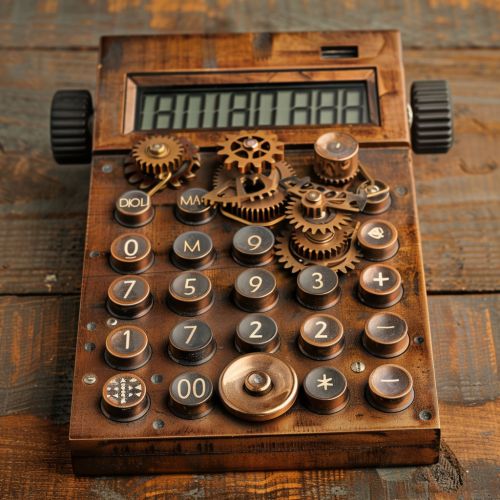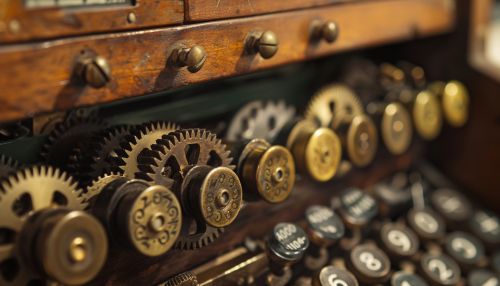Mechanical calculator
Introduction
A mechanical calculator is a device used for performing mathematical calculations through mechanical means. These devices were widely used before the advent of electronic calculators and computers. Mechanical calculators can perform basic arithmetic operations such as addition, subtraction, multiplication, and division. They have played a significant role in the history of computing and have evolved through various stages of development.
Historical Development
Early Mechanical Calculators
The history of mechanical calculators dates back to ancient times. The abacus is one of the earliest known mechanical devices used for calculations. It consists of beads that can be moved along rods to represent numbers and perform arithmetic operations. The abacus was used in various cultures, including ancient China, Greece, and Rome.
In the 17th century, significant advancements were made in the development of mechanical calculators. Blaise Pascal, a French mathematician, invented the Pascaline in 1642. The Pascaline was a mechanical calculator capable of performing addition and subtraction. It used a series of gears and wheels to represent and manipulate numbers.
18th and 19th Century Innovations
The 18th and 19th centuries saw further innovations in mechanical calculators. Gottfried Wilhelm Leibniz, a German mathematician, developed the Leibniz wheel in the late 17th century. This device could perform multiplication and division in addition to addition and subtraction. The Leibniz wheel used a stepped drum mechanism to achieve these operations.
In the 19th century, Charles Babbage, an English mathematician and inventor, designed the Difference Engine and the Analytical Engine. The Difference Engine was intended to automate the calculation of polynomial functions, while the Analytical Engine was a more general-purpose mechanical computer. Although Babbage's machines were never fully completed during his lifetime, they laid the groundwork for future developments in computing.
20th Century Developments
The 20th century saw the mass production and widespread use of mechanical calculators. One of the most notable mechanical calculators of this era was the Comptometer, invented by Dorr E. Felt in 1887. The Comptometer was a key-driven calculator that allowed for rapid and efficient arithmetic calculations.
Another significant development was the Curta calculator, invented by Curt Herzstark in the 1940s. The Curta was a small, hand-cranked mechanical calculator that could perform addition, subtraction, multiplication, and division. It was highly regarded for its precision and portability.


Mechanisms and Operation
Basic Components
Mechanical calculators typically consist of several key components, including gears, levers, and wheels. These components work together to represent and manipulate numbers. The gears are often arranged in a series of interconnected wheels, each representing a different digit of a number.
Addition and Subtraction
Addition and subtraction in mechanical calculators are usually performed through the rotation of gears. When a number is entered into the calculator, the corresponding gears are rotated to represent the digits of the number. To add two numbers, the gears representing the second number are rotated, causing the gears representing the first number to advance. Subtraction is performed similarly, but in the opposite direction.
Multiplication and Division
Multiplication and division are more complex operations that often require additional mechanisms. The Leibniz wheel, for example, uses a stepped drum mechanism to perform these operations. In multiplication, the number to be multiplied is entered into the calculator, and the drum is rotated a number of times equal to the multiplier. Division is performed by repeated subtraction, with the drum rotating in the opposite direction.
Applications and Impact
Scientific and Engineering Calculations
Mechanical calculators were widely used in scientific and engineering fields for performing complex calculations. They were essential tools for engineers, mathematicians, and scientists before the advent of electronic calculators and computers. Mechanical calculators enabled the accurate and efficient computation of mathematical functions, which was crucial for various scientific and engineering applications.
Business and Commerce
In addition to scientific and engineering applications, mechanical calculators were also used in business and commerce. They were commonly used for accounting, bookkeeping, and financial calculations. The ability to perform rapid and accurate arithmetic operations made mechanical calculators valuable tools for businesses.
Decline and Legacy
The widespread use of mechanical calculators began to decline with the advent of electronic calculators in the mid-20th century. Electronic calculators, which use electronic circuits to perform calculations, are faster, more accurate, and more versatile than mechanical calculators. As a result, mechanical calculators were gradually phased out in favor of electronic devices.
Despite their decline, mechanical calculators have left a lasting legacy in the history of computing. They represent an important step in the development of computational devices and have influenced the design of modern computers. Many mechanical calculators are now considered valuable historical artifacts and are preserved in museums and collections around the world.
